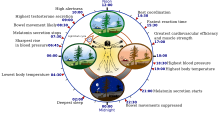« Back to Glossary IndexHistory and Discovery of Circadian Rhythms:
– Theophrastus recorded a circadian process in the 4th century BC.
– Chinese medical texts from the 13th century mention circadian processes in humans.
– The term ‘circadian’ was coined by Franz Halberg in 1959.
– Circadian rhythms were independently discovered in fruit flies in 1935.
– The Nobel Prize in Physiology or Medicine 2017 was awarded for discoveries in the Drosophila circadian system.
Mutations and Criteria of Circadian Rhythms:
– The first mammalian circadian clock mutation was discovered in mice in 1994.
– Deletion of the clock gene in recent studies did not affect circadian rhythms in animals.
– A circadian rhythm must have an endogenous free-running period of approximately 24 hours.
– Circadian rhythms are entrainable by external stimuli.
– Diurnal animals have τ slightly greater than 24 hours, while nocturnal animals have τ shorter than 24 hours.
Importance and Effects of Circadian Rhythms in Animals:
– Circadian rhythmicity influences sleeping and feeding patterns in animals.
– Core body temperature, brain wave activity, hormone production, and cell regeneration follow circadian patterns.
– Mutations in clock genes in mice affect cellular/metabolic events.
– Timely prediction of seasonal changes is crucial for survival.
– Changing photoperiods are predictive of seasonal physiology and behavior.
Effect of Light-Dark Cycle and Circadian Disruption:
– Animals in total darkness develop a free-running rhythm.
– Blind subterranean mammals maintain their circadian rhythms without external cues.
– Mutations in clock genes in mice affect cellular/metabolic events.
– Light therapy has been tested as a treatment for sleep disorders.
– Clock-mutant mice show traits like hyperphagia and obesity.
Circadian Rhythms in Plants and Drosophila:
– Plant behaviors showing rhythms: leaf movement, growth, germination, stomatal/gas exchange, enzyme activity, photosynthetic activity, and fragrance emission.
– Clock genes discovered in Drosophila play a key role in circadian rhythm.
– Matching plant circadian rhythms with light/dark cycles positively affects plant growth.
– Research on spacecraft environments has been influenced by circadian rhythm studies.
– The molecular circadian clock can function within a single cell.
Circadian rhythm (Wikipedia)
A circadian rhythm (), or circadian cycle, is a natural oscillation that repeats roughly every 24 hours. Circadian rhythms can refer to any process that originates within an organism (i.e., endogenous) and responds to the environment (is entrained by the environment). Circadian rhythms are regulated by a circadian clock whose primary function is to rhythmically co-ordinate biological processes so they occur at the correct time to maximise the fitness of an individual. Circadian rhythms have been widely observed in animals, plants, fungi and cyanobacteria and there is evidence that they evolved independently in each of these kingdoms of life.
| Circadian rhythm |
|---|
 Features of the human circadian biological clock |
| Pronunciation | |
|---|
| Frequency | Repeats roughly every 24 hours |
|---|
The term circadian comes from the Latin circa, meaning "around", and dies, meaning "day". Processes with 24-hour cycles are more generally called diurnal rhythms; diurnal rhythms should not be called circadian rhythms unless they can be confirmed as endogenous, and not environmental.
Although circadian rhythms are endogenous, they are adjusted to the local environment by external cues called zeitgebers (from German Zeitgeber (German: [ˈtsaɪtˌɡeːbɐ]; lit. 'time giver')), which include light, temperature and redox cycles. In clinical settings, an abnormal circadian rhythm in humans is known as a circadian rhythm sleep disorder.
 Marko Kadunc
Marko Kadunc 

